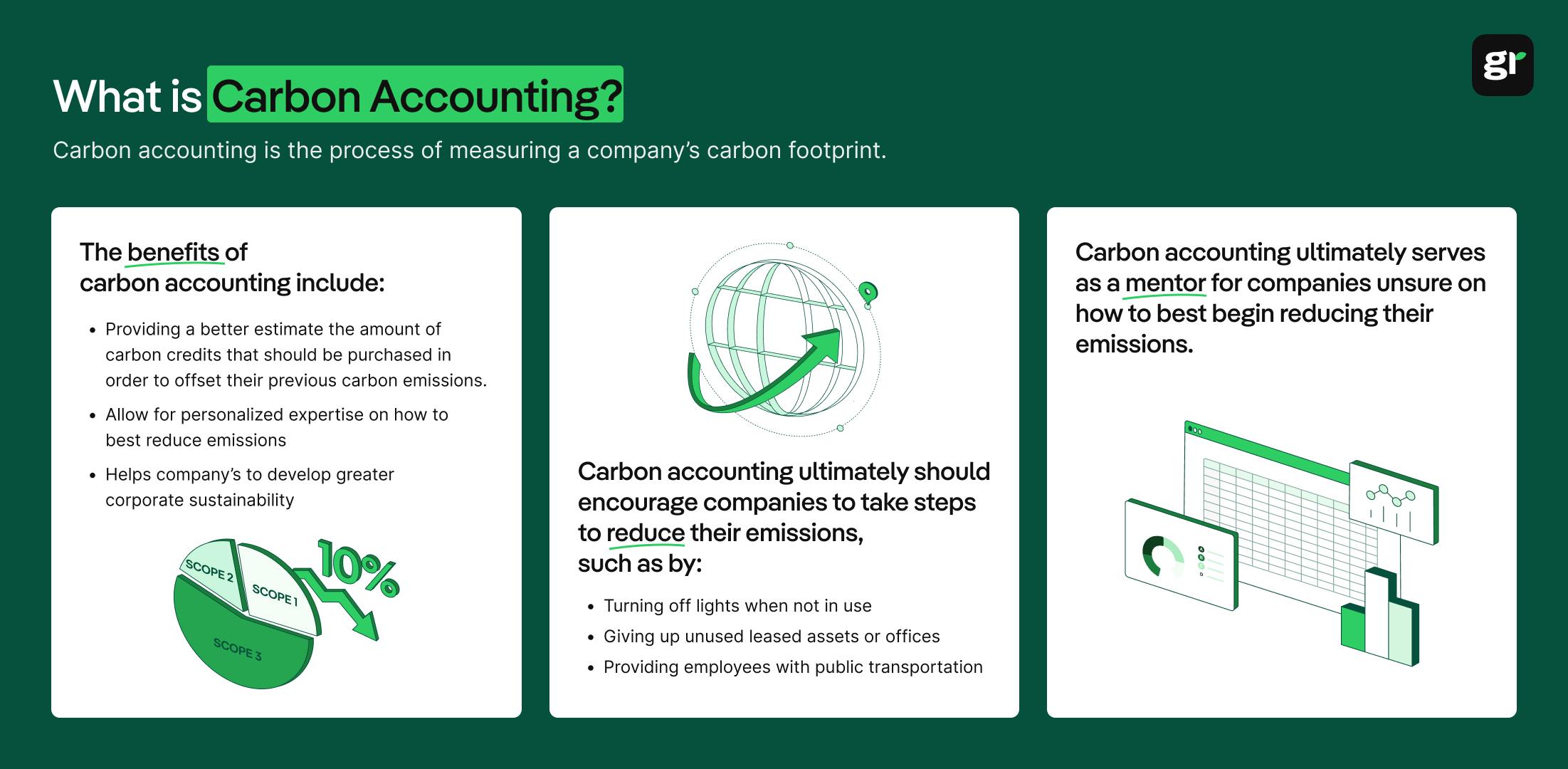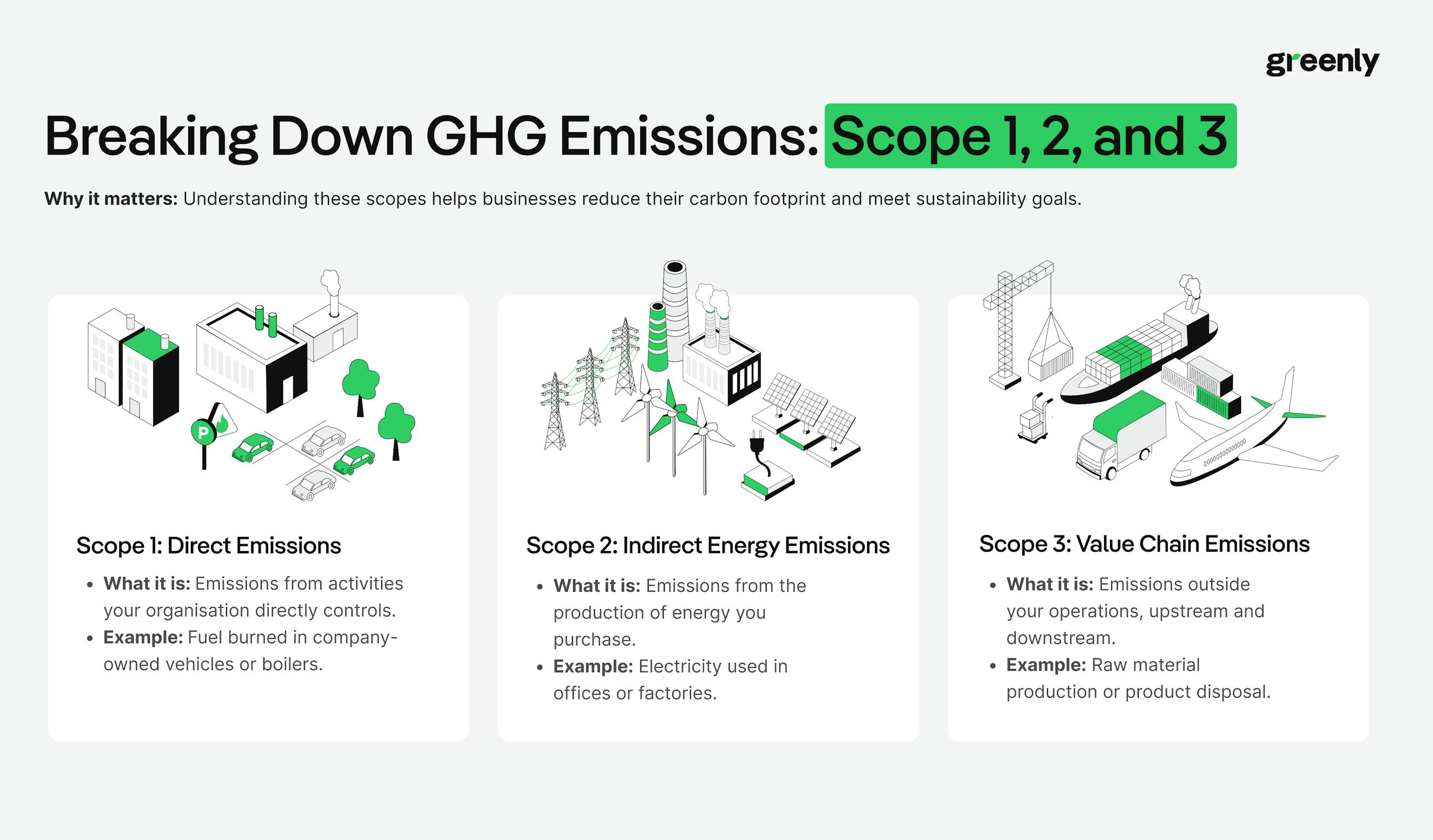
California Climate Accountability Package: SB253, SB261, & SB252
What is the California Climate Accountability Package, and how do SB 253 and SB 261 (SB 219), and SB 252 help the state work towards their environmental goals?
ESG / CSR
Industries



Global warming is taking the world by storm, in both our personal lives as well as the business world.
As the movement to join the net-zero movement to reduce emissions by 2050 grows exponentially, more and more companies are becoming interested in carbon accounting to help them reduce their emissions and create a better future for the environment.
Carbon accounting is broken down into three well-known categories called, “scopes”.
In this article, we'll break down what are scope 1 emissions, the importance of measuring and managing scope 1 emissions, and how they are different from scope 2 and scope 3 emissions.
Scope 1 emissions are greenhouse gasses that are produced directly at the source of the industrial activity of the company.
For example, at a Ford car manufacturing center, the emissions created by the actual production of the cars at that said facility would fall under scope 1 emissions.
Therefore, scope 1 emissions are the only emissions that are directly produced by the organization themselves.
The vertical timeline below will reveal how scope 1 emissions are created:
Fuel burned in company-owned boilers, furnaces, ovens, heaters, and turbines at facilities (e.g., natural gas, diesel, fuel oil) releases direct CO₂, CH₄, and N₂O.
Gasoline, diesel, CNG, or LPG used in company vehicles, forklifts, ships, or aircraft produces tailpipe emissions owned or controlled by the company.
Leaks and servicing losses from HVAC, refrigeration, heat pumps, or fire-suppression systems release high-GWP gases (e.g., HFCs) directly into the atmosphere.
Chemical/industrial reactions inside owned equipment (e.g., cement clinker and lime calcination, metal smelting, hydrogen or ammonia production) emit CO₂ and other gases.
Fuel used in on-site generators, microturbines, or combined heat & power (CHP) units to make electricity/steam for operations creates direct GHG emissions.
Standby generators, compressors, and safety-relief vents that combust fuel during tests or outages contribute to Scope 1 when owned or controlled by the company.
Emissions from company-owned waste incineration or flaring, and methane from on-site wastewater or landfills operated by the company, are also Scope 1.
Carbon accounting is a method companies use to determine the culprit behind their own carbon footprint. In other words, carbon accounting helps companies break down their emissions into categories, otherwise known as “scopes''.


These scopes aim to break down the sources of activity which produce carbon dioxide emissions, so that a company can better understand their carbon footprint.
Carbon accounting is also referred to as greenhouse gas accounting.
Carbon accounting has been gaining recognition, as it often serves as the first step when companies decide they are ready to comprehend their own carbon footprint – and allows them to determine the next steps necessary to reduce their own carbon emissions.
As climate change continues to negatively impact life around the globe, carbon accounting has become more pivotal than ever before. This is because carbon accounting serves as an excellent first step for companies to transition into sustainable business patterns that the environment will thank them for.
Carbon accounting not only helps to reduce emissions and establish that a company is making an effort to be more sustainable, but it can persuade a company to make long-lasting, positive environmental change. For example, if a company sees that much of their emissions are being created by the vehicles in their company – they may be inspired to invest in electric cars to mitigate the amount of greenhouse gasses and pollution they are contributing to.
The overview cards below will reveal why carbon accounting is important for organizations to successfully reduce emissions long-term:
Provides a reliable record of Scope 1, 2, and 3 emissions, ensuring transparency and accuracy in sustainability reporting.
Helps organizations set measurable science-based targets and track progress toward net-zero commitments.
Reveals inefficient processes and high-emission operations, enabling smarter investments and resource optimization.
Empowers executives with data-driven insights for strategy, budgeting, and sustainability initiatives.
Strengthens credibility with investors, regulators, and customers through transparent and verifiable climate reporting.
Encourages continuous improvement by integrating emission insights into daily operations and long-term planning.
Carbon accounting can also prevent greenwashing – which is when a company claims to be “greener” than they actually are. Carbon accounting does this by numerically delineating the areas where a company is successfully mitigating emissions, and where they can aim to improve their carbon footprint.
Lastly, carbon accounting can increase revenue and their overall finances – more investors and customers are becoming aware of the importance of investing or purchasing products that seek to be sustainable, avoid waste, and don’t contribute to climate change.
Scope 1 emissions are often the category first looked at in carbon accounting. So, does that mean they’re the most important – or do scope 2 and scope 3 emissions play just a big part in a company’s carbon footprint?

Scope 1 emissions are important because they are the only category of emissions in carbon accounting that can be completely controlled by the company.
The interactive flip cards below (move cursor over card to flip) will reveal some of the main reasons why scope 1 emissions are important:
The business has full authority to implement new equipment or business strategies to reduce the emissions in scope 1 emissions, whereas a company is not able to do the same with scope 2 emissions or scope 3 emissions.
Scope 1 emissions can help to reduce the amount of energy and emissions produced in scope 2 emissions. Therefore, it can be said that scope 1 emissions serve as the baseline for the future of all emissions to be produced by the company.

As a whole, scope 1 emissions (like any emissions created by a company) play a role on the company's carbon footprint – but scope 1 emissions are generally easier to measure and manage, especially in comparison to scope 3 emissions (which are notoriously difficult to effectively define and reduce).
Scope 1 emissions have the potential to reduce the amount of emissions created in scope 2, which do play a role in the amount of carbon dioxide emissions produced by a company. Therefore, while scope 2 emissions don’t require the most upkeep – they are like the root of any other problem.
If you make an effort to reduce the amount of emissions being produced at the source, or at least improve the efficiency of the equipment, it could very well help to reduce your scope 2 emissions as well.
The battle cards below will reveal the differences between scope 1, scope 2, and scope 3 emissions:


Scope 1 emissions in carbon accounting can help demonstrate the importance of altering your company’s business model or industrialization tactics to reduce emissions. However, many of these changes are often not an immediate option for companies to reduce their emissions, and take time to successfully implement.
So, what are the other ways you can reduce your environmental impact that aren’t specific to scope 1 emissions?
Here are 3 ways that your company can lower your overall carbon emissions and join the fight against climate change.
Everything requires power to operate, but does it need to be running when you’re not there?
Your company should strive to reduce their energy consumption whenever possible, and one of the biggest culprits of excessive energy use is when the heat, air conditioning, or lights are left on inhabited spaces.
Turn off lights and heating or air cooling systems where they aren’t necessary, and your company could help the environment while reducing their electricity bill at the same time!
Even better, see if your company can aim to use renewable energy sources instead of fossil fuels. This way, your company might be able to keep up with their production goals whilst still preserving the atmosphere.

It’s understandable that a massive change in your production habits isn’t financially feasible, especially for new companies. Pieces of equipment that drastically reduce carbon dioxide emissions from the source of activity, like a carbon capture and storage system – are expensive and require heavy labor to install.
You may not be able to change the production line of your company with ease, but how about the packaging?
Customers aren’t fond of excessive plastic or paper that they need to throw out after opening the product they ordered anyways, so why not strive to make your packaging environmentally friendly?
Here are some ideas on more sustainable materials to use for your product's packaging:
Grows into custom shapes, compostable at home, and replaces foam inserts for protective packaging.
Fast-growing, renewable pulp for trays, clamshells, and wraps with strong, lightweight performance.
Durable, low-input crop; great for molded pulp, papers, and biodegradable cushioning.
High post-consumer content, widely recyclable, ideal for boxes, sleeves, and void fill.
Bio-based, edible/compostable films for sachets and wraps; dissolves or degrades rapidly.
Upcycled fiber from cane processing; sturdy molded trays and mailers, compostable.
Plant-based films and thermoforms; compostable where industrial facilities exist.
Infinitely recyclable with high value recovery; great for tins, closures, and rigid packs.
Smooth, translucent, grease-resistant paper; recyclable alternative to plastic sleeves.
Even small businesses can implement sustainable packaging into their business. It doesn’t have to break the bank: just be mindful if the packaging is made with recycled or raw materials, can be reused, and doesn’t create a large carbon footprint to produce in the first place.
This is a really easy way for companies to reduce their carbon footprint and demonstrate their commitment to reducing emissions while maintaining their budget.
There’s a reason why Teslas and electric car charging stations are becoming more popular. The Biden administration is even encouraging Americans to do so in the new climate bill by providing them with a tax credit if they decide to purchase an electric car over a gasoline powered car.
Not only is an electric car better for the environment, but it’s better for your gas bill. It may seem like a large investment at first, but over time – the amount of money and time you’ll save no longer filling up your car for gas will become indispensable to both you and the planet.
If reading this article about scope 1 emissions has made you interested in reducing your carbon emissions to further fight against climate change – Greenly can help you!
Greenly can help you make an environmental change for the better, starting with a carbon footprint assessment to know how much carbon emissions your company produces.
Click here to learn more about Greenly and how we can help you reduce your carbon footprint.